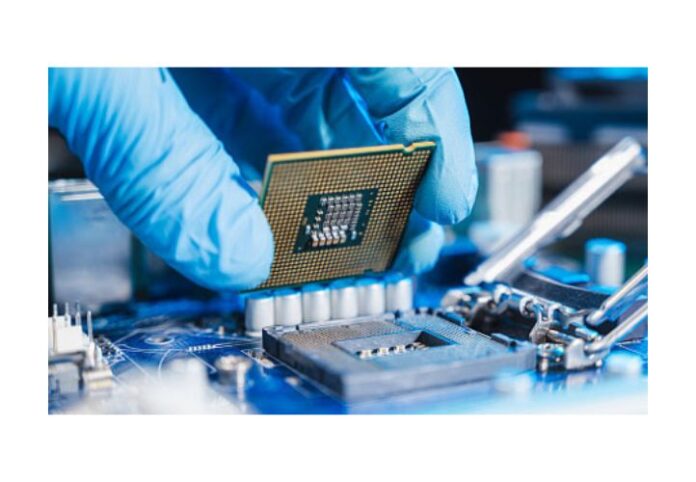News Release
BLOOMINGTON — In what is one of the largest commitments made by a college or university to high-tech industry and national defense, Indiana University has secured and will invest at least $111 million over the next several years to advance its national leadership in microelectronics and nanotechnology.
The university’s investment will boost the growth of the microelectronics industry in Indiana and across the U.S. and accelerate innovative solutions to major national security challenges through enhanced collaboration with Naval Surface Warfare Center, Crane Division. Crane Division
Collectively, IU’s current and forthcoming investments will address emerging semiconductor technologies, drive talent development and respond to critical defense needs. They include financial support for new faculty hires, facilities, equipment and strategic initiatives focused on advancements in microelectronics, nanotechnology, artificial intelligence, machine learning and cybersecurity.
Aligned with the business and industry engagement objectives of the new IU 2030 strategic plan, IU’s investments will also support partnerships with defense contractors and companies working to develop dual-use technologies — those that can be used in defense and civilian applications.
“The significant investments we’re making in academic and research programs, new faculty appointments, state-of-the-art facilities and future-focused collaboration with industry will strengthen IU’s national leadership, further develop Indiana’s microelectronics sector and drive our state’s current and future economic competitiveness,” IU President Pamela Whitten said. “They also reflect a shared mission between IU and NSWC Crane to drive deeper strategic collaboration and build the innovative technologies and capabilities critical to our nation’s security and prosperity.”
Whitten outlined IU’s current and future financial commitments to strengthen its partnership with NSWC Crane during a recent series of meetings at the center, which supports the electronics and engineering needs of the U.S. Navy and other military entities. One of southern Indiana’s largest employers, NSWC Crane is based at NSA Crane, the third-largest naval installation in the world, 40 minutes southwest of the IU Bloomington campus.
IU’s investments in microelectronics and to support its partnership with NSWC Crane and industry include:
- As part of IU Bloomington’s Faculty 100 hiring initiative, investing $23.5 million over the next five years to recruit 25 new faculty members in microelectronics, nanotechnology, artificial intelligence, machine learning and cybersecurity. IU will focus on hiring faculty with Department of Defense experience, as well as the creativity and entrepreneurial ability to develop dual-purpose technologies and capabilities.
- Investing $53.5 million in laboratories and other facilities, equipment and faculty start-up costs to support key research areas with defense applications; increase research partnerships; expand federal grants and contracts; and create additional opportunities for IU and Crane personnel to collaborate.
- Announcing today a $10 million investment to launch the new Center for Reliable and Trusted Electronics, which will lead research activities focused on the modeling and simulation of radiation effects and the design of radiation-hardened technologies. The center, to be known as IU CREATE, will build on an existing initiative at the IU Luddy School of Informatics, Computing and Engineering supported by a $5 million grant from NSWC Crane and an additional $1 million from the Indiana Economic Development Corp. that is focused on building and testing microelectronics in extreme environments.
- Implementing new degree programs to train students in microelectronics and nanofabrication and investing in nanofabrication facilities to support IU programs and the IU-NSWC Crane partnership. The total developmental, renovation and equipment, and operational commitment will be $13.5 million.
- Committing $1 million for each of the next five years to support innovative faculty research in key technology areas such as biotechnology and synthetic biology.
“The elevated importance of NSWC Crane’s mission has created new and robust opportunities for dramatically advancing the longstanding and highly productive IU-Crane partnership, accelerating innovative solutions to national security challenges and ensuring that Indiana is at the forefront of the critical industries of today and tomorrow,” IU Vice President for Research Russell Mumper said. “We will continue to harness the power of IU’s vast research enterprise to support this growing partnership, with a special emphasis on industries and companies important to Crane, including those developing dual-use technologies.”
Contributing to Indiana’s microelectronics sector
Noting that IU was one of the first universities to support the CHIPS and Science Act, Mumper said the university’s investments will enable the further development of Indiana’s CHIPS and Science Act strategy.
The legislation calls for a historic national investment of nearly $280 billion in new funding to boost domestic research and manufacturing of semiconductors. The Silicon Crossroads Microelectronics Commons Hub, led by Indiana’s Applied Research Institute with support from IU, was recently named by the Department of Defense as one of eight regional innovation hubs — a designation made possible through CHIPS.
The investments will also enable new collaboration with NSWC Crane, other universities and industry at WestGate@Crane Technology Park, located adjacent to NSWC Crane. The park is emerging as a critical component of the region’s economy, fueled by the announcement of a new microelectronics campus at WestGate, which will attract at least four semiconductor companies and create up to 549 jobs.
Indicative of IU’s commitment to expanding talent pipelines across the sector, Whitten is also co-leading the EDGE Consortium with Sian Leah Beilock, President of Dartmouth. The consortium of leading public and private universities will launch later this month at a summit in Washington, D.C., and is focused on expanding the nation’s microelectronics and semiconductor workforce, including efforts to expand the ranks of women and individuals from historically underrepresented groups within microelectronics and related sectors.
The Oct. 24 EDGE Summit will include representatives from academic, industry and government who will explore strategies for achieving a more diverse engineering workforce and spotlighting successful efforts.





